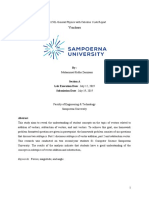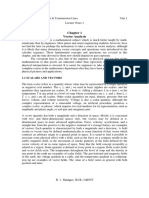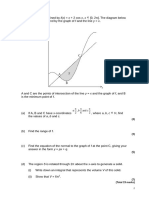Lecture Guide in Vector Analysis
Uploaded by
Anonymous KbUDRGqRKLecture Guide in Vector Analysis
Uploaded by
Anonymous KbUDRGqRKELECTRONICS ENGINEERING DEPARTMENT
Abstract
electronicsengineering@tip.edu.ph
[Draw your reader in with an engaging
abstract. It is typically a short
summary of the document.
When youre ready to add your content, just click here and start typing.]
LECTURE GUIDE IN
VECTOR ANALYSIS
Prepared by: Engr. John Joel F. Martinez
Lecture Guide in Vector Analysis
Introduction to Vector Analysis
At the end of this session, the student should be able to:
Classify Scalar quantity and Vector Quantity
Represent a Vector, graphically, on a three-dimensional rectangular coordinates
system
Express vector field as an equation using rectangular coordinates and unit
vectors
Solve problems using rules in vector operations
1.1 Why study vector analysis?
Vector analysis, which had its beginnings in the middle of the 19 th century, has in
recent years become an essential part of mathematical background required for
engineers, physicists, mathematicians and other scientists. This requirement is far
more accidental, for not only does vector analysis provide a concise notation for
presenting equations arising from mathematical formulations of physical and
geometrical ideas. In short, it might very well be considered a most rewarding
language and mode of thought for the physical sciences. (Spiegel, 1959)
1.2 What are Scalar and Vector quantities
Scalar refers to quantity whose value maybe represented by a single (positive or
negative real number) only. Quantities that are scalar are those parameters that are
taken at a single point in space (ex. temperature at certain part in a tea cup) or
measured at a specific time (distance from the ground of a falling body at a certain
time). Some scalar quantities are mass, density, pressure, volume and volume
resistivity.
Vectors are n-dimensional quantities that has both magnitude and direction. In
this course, however, only two and three dimensional vectors are considered. Force,
velocity, acceleration, and a straight line from the positive or negative terminal of a
storage battery are examples of vector. Conversely, vectors are physical quantities
that has either a spatial direction or a change in its value.
In vector analysis, well be more interested in scalar and vector fields. A field
maybe defined mathematically as some function of that vector which connects an
arbitrary origin to a general point in space. Usually, fields are associated to some
physical effect, such as force on a compass needle in the magnetic field, or the
movement of smoke particles in the field defined by the vector velocity of air in some
region of space. Field concept are invariably related to some region in space. Some
ELECTRONICS ENGINEERING DEPARTMENT
WEEK 1 - VECTOR ALGEBRA PAGE 1
Lecture Guide in Vector Analysis
example of Scalar field are the temperature of soup throughout the bowl of soup and
the density at any point in the earth. The gravitational and magnetic fields of earth,
the voltage gradient in a cable, and the temperature gradient in a soldering tip are
examples of vector fields. The value of a field varies in general with both position
and time.
Activity 1.1
Classify each quantity as vector or scalar.
a. Distance
b. Computer Memory (bytes)
c. Heat
d. Energy
e. Acceleration
f. Bearing
g. Momentum
h. Displacement
i. Work
j. Pressure
k. Area
l. Entropy
m. Drag
1.3 Vector Representation
Graphically, vector are represented by an arrow OP defining the direction, the
magnitude of the vector being indicated by the length of the arrow. The tail end O of
the arrow is called the origin or the initial point of the vector, and the head P is called
the terminal point or terminus.
Figure 1. Vector Arrow
Analytically, a vector is represented by a letter with an arrow over it, as
Fig. 1, and its magnitude is denoted by
in
| A |A . In other books, vector is also
represented by a bold face letter, A or the line segment
ELECTRONICS ENGINEERING DEPARTMENT
OP
or OP.
WEEK 1 - VECTOR ALGEBRA PAGE 2
Lecture Guide in Vector Analysis
Example 1.1
Present Graphically (a) Force of 10 lb in a direction
30
north of east.
(b) Force of 15 lb in a direction
30
east of north.
1.4 Vector in Rectangular coordinate system
1.4.1 Cartesian Coordinates
In order to describe a vector accurately, some specific lengths, directions, angles,
projections, or components must be given. There are three simple methods to
represent these properties and these are the rectangular, spherical and
cylindrical coordinate systems. In this section we will discuss the rectangular
coordinates.
In rectangular coordinates, three axes are mutually perpendicular to each other
respectively x, y and z.
Figure 2.a Three dimensional rectangular coordinate system
Figure 2.b P(1,2,3) and Q(2,-2,1) Plotted on the rectangular coordinates
It is customary to choose a right-handed coordinate system, in which a rotation of
the x-axis in y-axis would cause a right-handed screw to progress in the direction of
the z-axis. If the right hand is used, the middle finger, fore finger and thumb may be
identified as x, y, and z axes, respectively.
1.4.2 Vector Components
A logical way to represent a vector in three-dimension is to identify its three
component vectors, lying along the three coordinate axes, whose vector sum must
be the given vector. r = x + y + z
Figure 3. Vector
ELECTRONICS ENGINEERING DEPARTMENT
projected on a coordinate axes
WEEK 1 - VECTOR ALGEBRA PAGE 3
Lecture Guide in Vector Analysis
Each component vector have magnitude that depends on the given vector.
However, they also have known and constant direction and is always directed along
its corresponding axis, this is not always the case. To obtain the real direction of the
original vector we must use unit vectors. A unit vector is a vector whose magnitude
r
is unity or one. If r is a vector, with magnitude not equal to zero, then r is the
unit vector having the same direction of
r . Any unit vector can be represented as
a . In this case:
ar =
r
r
Thus,
a x , a y a z
are the unit vectors in the Cartesian coordinate system. They
are directed along the x, y and z axes, respectively.
Figure 4. Unit vectors in the Cartesian coordinate system
If the component vector
happens to be two units in magnitude and directed
toward increasing values of y, we should then write y =2 a y . Any vector B may
then be describe as
x + B y a y + B z a z . The magnitude of
B=B
xa
is given by:
B
B
B
2
( y ) +( z )2
( x)2 +
|B|=
Therefore, the unit vector in the direction of B is found as:
ELECTRONICS ENGINEERING DEPARTMENT
WEEK 1 - VECTOR ALGEBRA PAGE 4
Lecture Guide in Vector Analysis
B
B
B
2
( x) +( y)2 +( z )2
B a +B a + B a
aB = x x y y z z
Example 1.2
Given the figure below, (a) express
P
mathematically using the vector
components and unit vector as variable, (b) determine the magnitude of
and (c) the unit vector.
1.5. Vector Algebra
The operation of addition, subtraction and multiplication familiar in the algebra of
number of scalars are, with suitable definition, capable of extension to an algebra of
vectors.
1.5.1 Fundamentals of vector algebra
a) Two vectors
and
are equal if they have the same magnitude
and direction regardless of the position of their initial points. Thus
B .
A=
b) A vector having direction opposite to that of vector
same magnitude is denoted by - A .
ELECTRONICS ENGINEERING DEPARTMENT
A but having the
WEEK 1 - VECTOR ALGEBRA PAGE 5
Lecture Guide in Vector Analysis
Figure 5. Fundamentals of vectors
c) The sum or resultant of vector of A and B is a vector C formed by
placing the initial point of B on the terminal point of A and then
joining the initial point of A to the terminal point of B . The sum is
written A + B=C . This is also known as the Parallelogram law.
Extensions to sums of more than two vectors are immediate.
Figure 6. Vector addition
d)
The difference of vectors A and B , represented by A - B , is
that vector C which added B yields vector A . Equivalently,
B
A
can defined as the sum A +(B) .
by scalar m is a vector m A with
magnitude |m| times the magnitude of A and the direction the
same as or opposite to that of A , according as m is positive or
negative. If m=0, m A is the null vector.
e) The product of a vector
1.5.2 Laws of vector algebra
ELECTRONICS ENGINEERING DEPARTMENT
WEEK 1 - VECTOR ALGEBRA PAGE 6
Lecture Guide in Vector Analysis
If
A , B
and
are vectors and m and n are scalars, then
1.
B+
A
A + B=
Commutative Law for Addition
2.
C )=( A+
B ) + C
A + ( B+
Associative Law for addition
3. m A
A m
multiplication
4. m(n A )=(mn) A
5. (m+n) A = m A +m B
6. m( A + B =m A + m B
Commutative Law for
Associative Law for Multiplication
Distributive Law
Distributive Law
Example 1.3
1. Show that addition of vector is commutative.
2. Show that addition of vector is associative.
3. An automobile travels 3 miles due north, then 5 miles northeast. Represent
the displacement graphically and analytically.
4. Forces F1, F2, ., F6 acts on object P as shown. Show, graphically, the
Vector that will prevent P from moving.
ELECTRONICS ENGINEERING DEPARTMENT
WEEK 1 - VECTOR ALGEBRA PAGE 7
Lecture Guide in Vector Analysis
5. Given
A=3
ax 2 a y + a z
, B=2 a x 4 ay 3 az
and
C=
a x +2 a y +2 a z
Find the magnitudes of:
a) A
b)
C
A + B+
c) 2 A3 B5 C
Drill Problems 1.1
1. Given the vector
=10 a x + 6 a y 2 a z
M
and
N=8
ax +3 a y 2 az , find:
a) a unit vector in the direction of - M + 2 N
b) the magnitude of 5 a x + N3 M
c) | M 2 N |( M + N
2. Given three points, A(4,3,2), B(-2,0,5), and C(7,-2,1):
a) specify the vector A extending from the origin to point A
b) give the unit vector extending from the origin toward the midpoint of line
AB
c) calculate the length of the perimeter of triangle ABC
3. The vector from the origin to point A is given as 6 a x 2 ay 4 a z ,
and the unit vector directed from the origin toward point B is (2/3,-2,3,1/3).
If points A and B are 10 units apart, find the coordinate of point B
4. Given A=3 ax a y 4 a z , B=2 ax + 4 ay 3 az and C=a x + 2 a y a z
Find:
a) 2 A B+3 C
b) A + B+ C |
ELECTRONICS ENGINEERING DEPARTMENT
WEEK 1 - VECTOR ALGEBRA PAGE 8
Lecture Guide in Vector Analysis
c) |3 A2 B+4 C
d) a unit vector parallel to 2 A B+3 C
5. The following forces acts on a particle P:
F 2=5 ax + ay +3 a z , F 3=ax 2 a y + 4 a z
and
F 1=2 ax + 3 ay 5 a z ,
F 3=4 ax 3 a y 2a z
a) Find the resultant of the forces
b) Magnitude of the resultant
c) unit vector of the resultant
ELECTRONICS ENGINEERING DEPARTMENT
WEEK 1 - VECTOR ALGEBRA PAGE 9
You might also like
- DR External Axis Controller (1L4805A-E-3) PDFNo ratings yetDR External Axis Controller (1L4805A-E-3) PDF160 pages
- Vector Analysis: 1.1 Scalars and VectorsNo ratings yetVector Analysis: 1.1 Scalars and Vectors9 pages
- Vector Analysis: 1.1 Scalars and VectorsNo ratings yetVector Analysis: 1.1 Scalars and Vectors9 pages
- Vector Analysis: 1.1 Scalars and VectorsNo ratings yetVector Analysis: 1.1 Scalars and Vectors9 pages
- 1-Vector Analysis-Algebra and Basics of Vector SY 2020-2021 - ECENo ratings yet1-Vector Analysis-Algebra and Basics of Vector SY 2020-2021 - ECE46 pages
- Elements of Electromagnetics Third Edition E Book Chapter 01No ratings yetElements of Electromagnetics Third Edition E Book Chapter 0126 pages
- Vector Analysis From Scratch (Math Beyond Numbers) (David Smith)No ratings yetVector Analysis From Scratch (Math Beyond Numbers) (David Smith)198 pages
- 03 Equilibrium of Concurrent Forces Force TableNo ratings yet03 Equilibrium of Concurrent Forces Force Table6 pages
- Textbook of Vector Analysis and Coordinate Geometry 9350843145 9789350843147 CompressNo ratings yetTextbook of Vector Analysis and Coordinate Geometry 9350843145 9789350843147 Compress204 pages
- Unit 1 - Electromagnetic Field Theory - WWW - Rgpvnotes.inNo ratings yetUnit 1 - Electromagnetic Field Theory - WWW - Rgpvnotes.in35 pages
- Engineering-Electromagnetics-Chapter-1Version2 (1)No ratings yetEngineering-Electromagnetics-Chapter-1Version2 (1)27 pages
- Electromagnetics (EM) - The Study of Electric and Magnetic PhenomenaNo ratings yetElectromagnetics (EM) - The Study of Electric and Magnetic Phenomena12 pages
- Engineering Mechanics I Teaching Material 2017No ratings yetEngineering Mechanics I Teaching Material 201773 pages
- IIT JEE Physics Free Notes: Mechanics - Vectors and Scalars67% (3)IIT JEE Physics Free Notes: Mechanics - Vectors and Scalars4 pages
- Foundations of Mathematical Physics: Vectors, Tensors and Fields 2009 - 2010No ratings yetFoundations of Mathematical Physics: Vectors, Tensors and Fields 2009 - 201080 pages
- Scalars and Vectors Fundamentals of Physics Halliday, Resnick & WalkerNo ratings yetScalars and Vectors Fundamentals of Physics Halliday, Resnick & Walker16 pages
- Electricity and Magnetism 1st Edition Dr Munir H Nayfeh Dr Morton K Brussel all chapter instant download100% (6)Electricity and Magnetism 1st Edition Dr Munir H Nayfeh Dr Morton K Brussel all chapter instant download32 pages
- Barron's SAT Subject Test Physics-Pages-64-77No ratings yetBarron's SAT Subject Test Physics-Pages-64-7714 pages
- PHYS 102 First Lecture August 5, 2020 PDFNo ratings yetPHYS 102 First Lecture August 5, 2020 PDF24 pages
- SPH3U Vectors Online Activity: Download As A PDFNo ratings yetSPH3U Vectors Online Activity: Download As A PDF10 pages
- Chapter 1 Introduction To Biology and Laboratory RulesNo ratings yetChapter 1 Introduction To Biology and Laboratory Rules15 pages
- 2016 Heffernan Maths Methods Units 1 & 2 Exam 2 SolutionsNo ratings yet2016 Heffernan Maths Methods Units 1 & 2 Exam 2 Solutions16 pages
- Engineering Graphics - Lines: Mr.B.RameshNo ratings yetEngineering Graphics - Lines: Mr.B.Ramesh39 pages
- Detailed Lesson Plan in Mathematics For Demo100% (1)Detailed Lesson Plan in Mathematics For Demo5 pages
- Coordinate Geometry for JEE Main and Advanced 11th Edition S K Goyal download pdf100% (1)Coordinate Geometry for JEE Main and Advanced 11th Edition S K Goyal download pdf67 pages
- 1-Vector Analysis-Algebra and Basics of Vector SY 2020-2021 - ECE1-Vector Analysis-Algebra and Basics of Vector SY 2020-2021 - ECE
- Elements of Electromagnetics Third Edition E Book Chapter 01Elements of Electromagnetics Third Edition E Book Chapter 01
- Vector Analysis From Scratch (Math Beyond Numbers) (David Smith)Vector Analysis From Scratch (Math Beyond Numbers) (David Smith)
- Master the Fundamentals of Electromagnetism and EM-InductionFrom EverandMaster the Fundamentals of Electromagnetism and EM-Induction
- Textbook of Vector Analysis and Coordinate Geometry 9350843145 9789350843147 CompressTextbook of Vector Analysis and Coordinate Geometry 9350843145 9789350843147 Compress
- Unit 1 - Electromagnetic Field Theory - WWW - Rgpvnotes.inUnit 1 - Electromagnetic Field Theory - WWW - Rgpvnotes.in
- Engineering-Electromagnetics-Chapter-1Version2 (1)Engineering-Electromagnetics-Chapter-1Version2 (1)
- Electromagnetics (EM) - The Study of Electric and Magnetic PhenomenaElectromagnetics (EM) - The Study of Electric and Magnetic Phenomena
- IIT JEE Physics Free Notes: Mechanics - Vectors and ScalarsIIT JEE Physics Free Notes: Mechanics - Vectors and Scalars
- Foundations of Mathematical Physics: Vectors, Tensors and Fields 2009 - 2010Foundations of Mathematical Physics: Vectors, Tensors and Fields 2009 - 2010
- Scalars and Vectors Fundamentals of Physics Halliday, Resnick & WalkerScalars and Vectors Fundamentals of Physics Halliday, Resnick & Walker
- Electricity and Magnetism 1st Edition Dr Munir H Nayfeh Dr Morton K Brussel all chapter instant downloadElectricity and Magnetism 1st Edition Dr Munir H Nayfeh Dr Morton K Brussel all chapter instant download
- Chapter 1 Introduction To Biology and Laboratory RulesChapter 1 Introduction To Biology and Laboratory Rules
- 2016 Heffernan Maths Methods Units 1 & 2 Exam 2 Solutions2016 Heffernan Maths Methods Units 1 & 2 Exam 2 Solutions
- Coordinate Geometry for JEE Main and Advanced 11th Edition S K Goyal download pdfCoordinate Geometry for JEE Main and Advanced 11th Edition S K Goyal download pdf

























































































